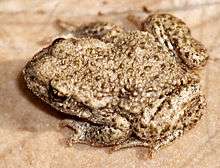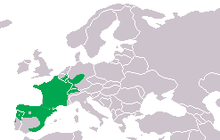Common midwife toad
The common midwife toad (Alytes obstetricans) is a species of midwife frog in the family Alytidae (formerly Discoglossidae). It is found in Belgium, France, Germany, Luxembourg, the Netherlands, Portugal, Spain, Switzerland, and the United Kingdom (although, in the latter, only as an introduction). Like other members of its genus (Alytes), the male toad carries the eggs around entwined on his back and thighs until they are ready to hatch.[2]
| Common midwife toad | |
|---|---|
 | |
| Scientific classification | |
| Kingdom: | Animalia |
| Phylum: | Chordata |
| Class: | Amphibia |
| Order: | Anura |
| Family: | Alytidae |
| Genus: | Alytes |
| Species: | A. obstetricans |
| Binomial name | |
| Alytes obstetricans (Laurenti, 1768) | |
 | |

Its natural habitats are temperate forests, dry forests, shrubland, rivers, freshwater lakes, freshwater marshes, temperate desert, arable land, pastureland and urban areas. It is threatened by habitat loss.
Description
The common midwife toad can grow to a length of 5.5 centimetres (2.2 in) but is usually rather smaller than this, the females generally being larger than the males. It is broad and stocky and has a large head with prominent eyes, the pupils being vertical slits. The skin is mostly smooth with a few small warts and granules and a row of large warts down either side. The parotoid glands are small and there are additional glands in the under arm and ankle regions. There are three tubercles on each metacarpal. The colour is quite variable, often being grey, olive or brown, sometimes speckled with small greenish or brown spots. The large warts are often reddish or yellow. The underside is pale grey often with spots of darker grey on the throat and chest.[3][4]
Distribution and habitat
The common midwife toad is found in a number of countries in north west Europe. It is common throughout France and is also found in southern Belgium and the Netherlands, Luxembourg, western Germany and northern and western Switzerland. There are some disconnected outlying populations in Portugal and northern Spain. In the Pyrenees it is found at altitudes of up to 2,400 metres (7,900 ft).[1] It is usually found not far from water but sometimes wanders 500 metres (1,600 ft) away, often living in sunny locations. These include hilly areas, cultivated land, quarries, rocky slopes, gravel pits, woods, parks and gardens. It is active at dusk and through the night, spending the day hidden in undergrowth, in crevices or under logs or stones in a place where it can keep damp. It can dig a burrow with its fore limbs in which to lie and spends the winter hibernating on land.[3]
Behaviour
When threatened, the midwife toad inflates itself, filling itself with air so as to make it appear as large as possible. It may also rear up on all four limbs, raise its rump and stand in a threatening posture with its head down and eyes shut.[3]
Reproduction takes place in spring and summer. The female seeks out a male and invites him to mate. Females are more prone to selecting larger males due to fitness preference.[5] He proceeds to hold her round the flanks and uses his toes to stimulate her cloaca. After about half an hour he squeezes her sides firmly and she stretches her hind legs and ejects a mass of eggs embedded in strings of jelly. The male releases her and inseminates the egg mass with his sperm. A little later, he begins to pull and pummel the egg mass, teasing it out so that he can wrap the strings around his back legs. He can mate again while the eggs are twined round his limbs and can carry up to three clutches of eggs at a time, a total of about 150 eggs. He looks after them until they hatch in 3 to 8 weeks time.[4] He keeps them moist by lying up in a damp place during the day and by going for a swim if they are in danger of drying out.[4] He may secrete a substance through his skin that protects them from infection. When the eggs are about to hatch, he finds a suitable stretch of water and releases them. He chooses cool, calm water such as a ditch, village pond, spring or drinking trough. The eggs hatch into tadpoles which feed and grow over the course of several months, develop limbs, lose their tails and eventually undergo metamorphosis, becoming juvenile toads. They may overwinter as tadpoles, becoming exceptionally large in the process.[3]
Role in history of biology, sociology of science
The 1971 book by Arthur Koestler The Case of the Midwife Toad,[6] brought the species a role in new thinking on the development of scientific paradigms based on the case of Paul Kammerer who claimed to have shown Lamarckian inheritance in experiments with the toad.
References
- Jaime Bosch; Trevor Beebee; Benedikt Schmidt; Miguel Tejedo; Iñigo Martínez-Solano; Alfredo Salvador; Mario García-París; Ernesto Recuero Gil; Jan Willem Arntzen; Carmen Diaz Paniagua; et al. (2009), Alytes obstetricans, 2009, p. e.T55268A87541047, doi:10.2305/IUCN.UK.2009.RLTS.T55268A11283700.en
- Alytidae AmphibiaWeb. Retrieved 2012-03-26.
- Arnold, Nicholas; Denys Ovenden (2002). Reptiles and Amphibians of Britain and Europe. London: Harper Collins Publishers Ltd. pp. 64–66.
- "Alytes obstetricans". AmphibiaWeb. Retrieved 2012-03-20.
- Raxworthy, C.J. (1990). "Non-random mating by size in the midwife toad Alytes obstetricans: Bigger males carry more eggs". Amphibia-Reptilia. 11 (3): 247. doi:10.1163/156853890X00168.
- Arthur Koestler (2016). The Case of the Midwife Toad. Dauphin Publications. ISBN 978-1-939438-45-4.
External links
- Sound recordings of Common midwife toad at BioAcoustica


